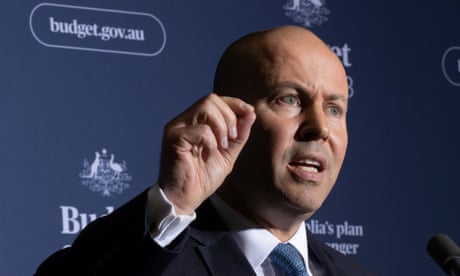If we move from Josh Frydenberg’s rhetoric to content, we discover this isn’t a serious plan for the future. This is a plan for the next few months.

The opening flourishes of Josh Frydenberg’s budget night speech certainly convey the gravity of our times. “Tonight, as we gather, war rages in Europe,” the treasurer told parliament. “The global pandemic is not over. Devastating floods have battered our communities.”
“We live in uncertain times.”
Indeed, we do.
But if we move from Frydenberg’s rhetoric to content, we discover this budget isn’t a serious plan for the future crafted by serious people in serious times.
This is a budget with one central objective: the re-election of the Morrison government in May.

With wages stagnant and consumer prices on the march, the Coalition’s primary pre-election gift to voters is cash for Australia’s low-and-middle income earners.
As well as cash, the government will cut the fuel excise in half in the hope a price cut at the bowser isn’t swallowed immediately by another adverse shift in the global oil price or an interest rate rise between now and September, when the excise is supposed to revert to its full rate.
This “temporary” assistance assumes there is some future benign political universe where either the current government, or a newly elected Labor one, can give Australians relief at the petrol pump, then take it away without incurring massive political pain – which has to be the working definition of the triumph of hope over experience.
Let’s believe the fuel excise reversion when we see it.
And the cost of “please like me”?
More than $8bn over the next two years.
The treasurer and the finance minister will say the following in their defence: most of the pre-election cash splash in this budget washes through. The spending isn’t baked in and much of the revenue uplift from Australia’s burgeoning post-pandemic economic recovery has been banked rather than spent.
Also true: had the Coalition done nothing in this budget to ease escalating cost-of-living pressures, they would have been belted politically.
The government insists its cash splash won’t feed inflationary pressures, which is obviously a significant risk to manage. But a pre-election handout north of $8bn is still a hefty price tag, however you look, however you measure.
Speaking of hefty price tags, this budget also finally squares the accounts between Scott Morrison, a prime minister who last year needed to land a commitment to net zero emissions by 2050, and Barnaby Joyce, a Nationals leader who wasn’t inclined to sign up unless the terms were favourable.
For graciously declining to humiliate Morrison at the Glasgow climate summit last year, Joyce has been rewarded with “transformational investments” (read many, many billions) for dams, roads and regional communications infrastructure.
“Thank you, Barnaby” includes about $3bn for inland rail, as well as $7.1bn over 11 years to “turbocharge the economies of four regional hubs across Australia”.
It’s probably a coincidence (yes, that is irony) that these hubs are located in the Northern Territory (two marginal seats there), north and central Queensland (Labor has its eye particularly on the electorate of Flynn), the Hunter in New South Wales (where the Nationals would very much like to snatch a seat from Labor) and the Pilbara in Western Australia.
This regional spend is north of $20bn over the medium term. I think the technical term for that is happy days on the Wombat Trail.
Given that this budget is very obviously political, and in Coalition terms, measurably transactional, Frydenberg and Morrison will insist they are about more than surviving an election contest.
I feel certain Exhibit A for future focus will be the national security spend – the magnificently named Redspice, which is (to quote the treasurer) “a $9.9bn investment in Australia’s offensive and defensive cyber capabilities” and “the biggest ever investment in Australia’s cyber-preparedness”.
The government says this initiative is all about meeting the challenges associated with the darkening geostrategic environment – which is very obviously a serious problem.
But take a moment to read the fine print. You’ll discover the investment to deal with this serious problem is loaded largely outside the forward estimates. The budget papers also make clear the expenditure will be “partly offset from the Defence Integrated Investment Program”.
Speaking of loudhailers, the 2022 election contest is now in sight. It could be days away. It could be a couple of weeks away. But it is close enough now to be real.
If we cast our minds back to 2007, when Labor was attempting to plot a pathway to government against an ageing Coalition government in whatever-it-takes mode, Kevin Rudd’s cut-through political riposte was “this reckless spending must stop”.
Back then, Rudd savaged John Howard’s “irresponsible spending spree” as a “desperate attempt” to buy a fifth term in government. Back then, the Reserve Bank was warning about government spending fuelling inflationary pressures and interest rate rises.
Audacious and supremely self-confident, Rudd backed himself to weaponise fiscal profligacy against Howard – to make the trinkets and tricks a symbol of a prime minister who cared more about the present than the future.
That effort succeeded.
But Anthony Albanese, ahead in the polls, and in small target mode, seems unlikely to adopt the Rudd playbook.
Given that Australians are struggling with rising prices – this is probably safe politics.
Safe, yes, but not entirely risk free.
Given that there is palpable disenchantment out in voter land, and given that the prime minister is working around the clock to convince people to stick with the devil they know in uncertain times, safe politics does raise one question.
Will Albanese present as sufficiently different from Morrison to be trusted by voters to chart a new course for Australia?
No comments:
Post a Comment